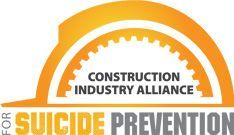GET INFORMED
WHY IS CONSTRUCTION THE MOST AT-RISK INDUSTRY FOR SUICIDE PREVENTION?
Male-dominated industries tend to have more suicides. The macho, tough guy and stoic nature of construction workers can even discourage those who are most at risk for suicide from seeking help. Men, especially white men in their early 20s through their 50s, account for the bulk of suicides.
According to the
Bureau of Labor Statistics, 97 percent of the U.S. construction workforce is male, and according to the American Foundation for Suicide Prevention, 38 percent of construction workers in the U.S. in 2018 were between the ages of 45 and 64.
With their mission-oriented mindsets, many veterans choose construction as a career. With an estimated 22 suicides per day, veterans are also at a higher risk of suicide than the general population.
Moving from site to site can create an environment in which workers are not as connected to their families, each other, or a workplace community. Coupled with working long or irregular hours, sleep patterns can be impacted, causing sleep deprivation and mental and physical exhaustion.
Layoffs due to seasonal work or economic downturns can have significant consequences. Not only does this increase the stress related to loss of income, but job loss also means employees may lose medical benefits and/or access to Employee Assistance Programs (EAPs). Additionally, the physical demands of construction work take a toll on the body and can cause physical or even chronic pain, which may lead to self-medication (with drugs, alcohol, or opioids). Opioid abuse is linked to an increased likelihood of a suicide attempt.
what can you do?
Whether you are a construction owner, executive, manager, supervisor, or field laborer, you can make a difference. There are practical steps you can take to help save lives. Raising awareness about mental health and suicide prevention is necessary, but it’s not enough to create a cultural change. This article demonstrates the need and impact of Breaking Down the Stigma: Prioritizing Mental Health in Construction.
where do you begin?
Whether your organization has taken the pledge to STAND up for suicide prevention, or if you’re just learning about the critical need to address suicide prevention in construction, CIASP has compiled tools and resources to help integrate suicide prevention into your company’s culture as a safety and health priority.
The Needs Analysis and Integration Checklist walks you through a series of questions to help evaluate your company’s suicide preparedness.
Then, the three-level document provides clear and simple steps to help your company address suicide prevention:
- Level 1 includes basic steps toward establishing a program to address employee mental health and suicide prevention.
- Level 2 grows the initial steps into a deeper commitment to the process.
- Level 3 outlines steps to create a company wide culture to address mental health and suicide prevention.
“Start the conversation with the CIASP Needs Analysis & Implementation Tool. It guides your discussion and builds an effective implementation plan. Every culture is different—use the tool to design a plan that best fits your organization and incorporates protective factors.”
-- Joe Xavier
Senior Director of Health and Safety
ABC- Associated Builders and Contractors
build awareness
- Construction + Suicide Prevention: Why Is This an Industry Imperative?
- Construction + Suicide Prevention: 10 Action Steps Companies Can Take to Save Lives
- Construction's Silent Killer Part 1 - Why is the Industry's Suicide Rate So High?
- Mental Health on the Jobsite.
- Start the Conversation video.
- CIASP ToolBox Talks
“The CIASP tools for supporting mental health have been a lifeline for me.. Your commitment to providing accessible and effective resources is commendable. Thank you for empowering Construction Managers like me to support our workers mental health and well-being. Your tools have made a profound impact on our ability to talk about suicide awareness and prevention, and I am grateful for your unwavering dedication, support, and genuine dedication to our industry.”
-- Jamie Evans
Senior Safety Director- New England
Turner Construction
VIDEO RESOURCES
The following videos may be used for individual viewing to become more informed, to supplement a presentation or webinar, or to incorporate into your employee training. The information has been divided into six videos to make it easier to disseminate and customize the use of the material.
Part 1:
Why Suicide Prevention in Construction?
Part 2:
CIASP Overview
Part 3:
Suicide and Mental Health Impact
Part 4:
Risk Factors
Part 5:
Warning Signs and What to Do
Part 6:
Suicide Prevention in the Workplace


